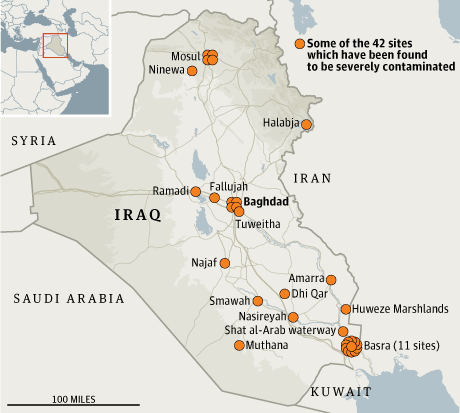Pollution caused by the bombing of oil pipelines and the type of munitions used in two wars have led to health problems in Barsa, southern Iraq
Martin Chulov
London Guardian
January 24, 2010
 |
More than 40 sites across Iraq are contaminated with high levels or radiation and dioxins, with three decades of war and neglect having left environmental ruin in large parts of the country, an official Iraqi study has found.
Areas in and near Iraq’s largest towns and cities, including Najaf, Basra and Falluja, account for around 25% of the contaminated sites, which appear to coincide with communities that have seen increased rates of cancer and birth defects over the past five years. The joint study by the environment, health and science ministries found that scrap metal yards in and around Baghdad and Basra contain high levels of ionising radiation, which is thought to be a legacy of depleted uranium used in munitions during the first Gulf war and since the 2003 invasion.
[efoods]The environment minister, Narmin Othman, said high levels of dioxins on agricultural lands in southern Iraq, in particular, were increasingly thought to be a key factor in a general decline in the health of people living in the poorest parts of the country.
"If we look at Basra, there are some heavily polluted areas there and there are many factors contributing to it," she told the Guardian. "First, it has been a battlefield for two wars, the Gulf war and the Iran-Iraq war, where many kinds of bombs were used. Also, oil pipelines were bombed and most of the contamination settled in and around Basra.
The Emergency Election Sale is now live! Get 30% to 60% off our most popular products today!


